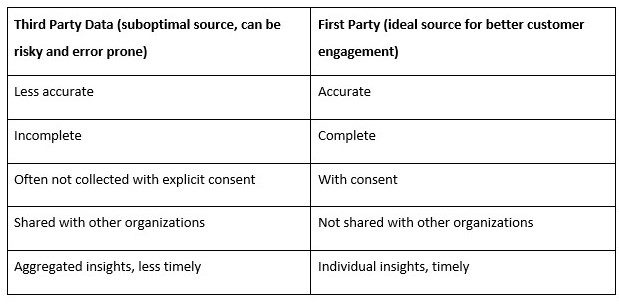The Gist
- First-party data is essential. First-party data offers higher accuracy and better personalization, making it vital for modern marketing.
- Privacy builds trust. Leveraging first-party data with customer consent strengthens trust and loyalty, essential for long-term success.
- Goodbye cookies. The shift from third-party cookies to first-party data isn’t just inevitable — it’s the smartest move for future-proof marketing.
Like some relationships, sometimes we have to move on. This is the case with third-party cookies and digital advertising. The future lies in first-party data and how it shapes the way we engage with customers.
While dependency on third-party cookies was previously the standard, the evolving news over the last few years set off a tremor of new trends. Consumers want relevant and timely experiences, but not at the cost of their privacy. And yet, some things don’t change. Marketing teams still need to measure the impact of those valuable ad dollars.
No one had time to wait around … we had work to do!
The Rise of First-Party Data in Digital Marketing
Teams needed to deliver personalized experiences and still track ROI, while expecting to lose access to third-party data. So, first-party data entered the chat. Higher quality and more timely than its cousin, third-party data, many marketers started to see how first-party data was better.
Related Article: What Now? First-Party Data Strategies in the Cookiepocalypse Apocalypse
Why First-Party Data is Crucial for Personalized Marketing
First-party data, collected directly from buyers such as current customers or website visitors, is typically more complete and accurate, making it crucial for delivering relevant experiences. This first-party data, provided with consent, also establishes deeper trust with customers.
It’s quite simple: as consumers grow savvier about data privacy, they prefer engaging with brands they trust. By offering personalized experiences that respect privacy and demonstrate value brands can create more lifelong customers!
Comparing Third-Party Data vs. First-Party Data for Marketing

Key Sources of First-Party Data for Marketers
Here are some examples of first-party data:
Data from:
- Behaviors or actions taken across your website, app, and/or product
- Point of sale via email or SMS
- Customer Relationship Management (CRM)
- Social media profiles
- Subscription-based emails or products
- Surveys
- Customer feedback
Measuring Success with First-Party Data and Conversion APIs
Now we have higher quality data for more relevant marketing, but what about measurement? When Google first announced that third-party cookies were going away, some savvy teams adopted the utility of Conversion APIs (CAPI). CAPI allows businesses to transmit data directly from their servers to their marketing platforms, minimizing reliance on browser cookies.
This method enhances control over data privacy, improves ad performance and ensures better attribution of marketing efforts. By combining first-party data with CAPI, companies can maintain robust data privacy standards while executing precision-targeted marketing campaigns.
Conclusion: Embracing First-Party Data for Future-Ready Marketing
We have made many changes over the last few years including our team structures, go-to-market, and, of course, our technology. First-party data is being adopted by more teams because it drives better business results and the end customer.
By embracing personalized, privacy-conscious practices as well as using technologies like CAPI and first-party data, companies can secure data control and foster deep customer trust. As technology continues to rapidly develop, we don’t have time to look back — and in this case, we don’t have to.
